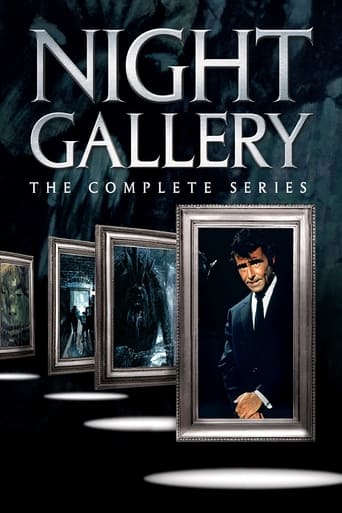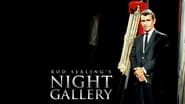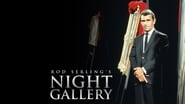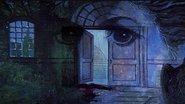AaronCapenBanner
This has often been considered a poor cousin to Rod Serling's other series "The Twilight Zone", and while it isn't in that league, it did present a number of standout segments like 'The Caterpillar', 'A Question Of Fear', 'The Devil Is Not Mocked', and my favorite 'Silent Snow, Secret Snow'.Rod would present each segment/episode by introducing a painting representing the basic story to be shown, and these paintings were usually quite chilling(like 'Pickman's Model'). There were some duds of course, mostly the comedic skits that were quite silly and pointless, though creator Jack Laird was said to be fond of them; season Two was the best of the three(take a bow Gerald Sanford!) Worth viewing, even if Mr. Serling wasn't as proud of it as he should have been...
paulbehrer22173
I've recently purchased the first and second seasons of Night Gallery on DVD and viewed them, and I have to admit that even after almost 40 years since the 3-segment pilot film, and the series itself, aired, it's still able to not only fill one's imagination with visions of all sorts of horrors, but also deals in sci-fi, fantasy, and nostalgia. 3 Bond Girls appeared here in this series: Martine Beswick (1 appearance, in the segment The Last Laurel, based on the short story The Horsehair Trunk by Davis Grubb, author of The Night of the Hunter), Lana Wood (1 appearance, in the segment You Can't Get Help Like That Anymore, where Wood appears as Model 931, a domestic android from Robot Aids, Inc who develops survival instincts which she uses against her abusive employers the Fultons, played by Broderick Crawford and Cloris Leachman), and Joanna Pettet (4 appearances in the series which are in the following order: the segment adapted by Rod Serling from the Andre Maurois short story The House, aired with its follow-up segment Certain Shadows on the Wall, which Serling adapted from the Mary Eleanor Wilkins Freeman short story The Shadows on the Wall, on December 30, 1970, Keep in Touch--We'll Think of Something, aired after The Dark Boy on November 24, 1971, The Caterpillar, aired on March 1, 1972, which was adapted by Serling from the short story Boomerang by Oscar Cook, which appeared in the anthology Switch on the Light, edited by Christine Campbell Thomson and published by Selwyn and Blount in London in 1931, and the segment adapted from the Fritz Leiber, Jr. short story The Girl with the Hungry Eyes by Robert Malcolm Young, which was aired on October 1, 1972). John Astin and Geraldine Page had 3 appearances apiece, Burgess Meredith, Agnes Moorehead, Vincent Price, Leslie Nielsen, Louise Sorel, and several other actors and actresses had 2 appearances here, with Bradford Dillman, Grayson Hall, and several others appearing in 1 segment for each season. I'm eagerly awaiting the 3rd season's release on DVD. It's simply a thought that I wished to express, nothing else. There aren't any spoilers present in this comment whatsoever.
gothick42
This is for the person who inquired about a cannibalism story involving Voodoo and a Hawaiian luau. This was not an episode of Night Gallery; it was one of the stories in the Amicus movie Tales that Witness Madness, which came out around the same time as Night Gallery was on (early Seventies). The Voodoo/cannibalism episode starred Kim Novak as the mother and Mary Tam (the first Romana on Dr. Who) as her daughter. The episode seemed to have been filmed missing the climactic twist ending. To put it mildly, the whole thing seemed to be a mistake. Still, it's fun to watch Kim Novak essaying an affected performance style that makes one wonder whether she was directed to play the role as a retired female drag queen!
notdempsey
If your anything like me, you've probably (to quote Marcellus Wallace) scoured the Earth for "Make Me Laugh," the second of two stories the young Spielberg shot for "Night Gallery." Not wanting to spend the 50 dollars on the DVDs, I patiently waited to find and record a re-run of the anthology.Before I review "Make Me Laugh," I'd like to say that Night Gallery is, for better or for worse, its own show made by many other talented directors and their casts and crews."Make Me Laugh" is not Spielberg's nor Sterling's finest hour. The story is very trite and the acting is weird and self aware. Sterling has written much better episodes than this unoriginal and pointless story of a down and out comedian granted the ability to make people laugh. The late great Godfrey Cambridge (Friday Foster) adds depth to the jaded jokester with extreme melodrama that is so over-the-top its kind of enjoyable. The same can't be said for Jackie Vernon, who played the genie. The genie character is dull, flat, and totally unreal. This is only made worse by bad makeup and a ridiculous costume. The pacing of the episode is minimal (surely due to time factors) but well done. And the lighting is natural. Professional, but not ground breaking.Spielberg wasn't given much wiggle-room on this one. A strict contract gave him almost no creative control, and this terrible script didn't help either. But it is an impressive effort for someone as young as Spielberg was. His visual style was still in the cooker, but there are compositions that are unique to television at the time and early heeds of Spielberg's natural-yet-abnormal frame. In the end, this episode was based on such a lame story that it never really had a chance no matter who was behind the camera. It is worth watching for its historical value, and for the strange performance of Cambridge. However, Spielberg's other Night Gallery outing "Eyes" is a much better example of an early version of Spielberg's framing and his excellent exposition.










